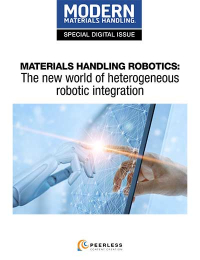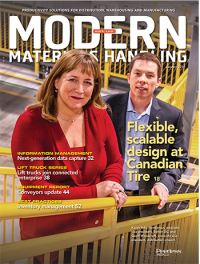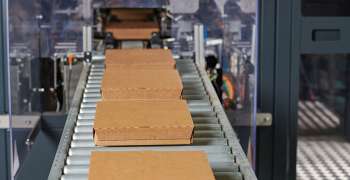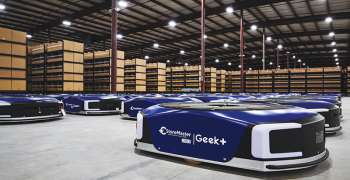60 Seconds with Ben Harris, Metro Atlantic Chamber
Our editors sat down with Ben Harris, Director of supply chain and advanced manufacturing for the Metro Atlantic Chamber to discuss On-demand delivery.
Ben Harris
Location: Atlanta, Ga.
Primary duties: Director of supply chain and advanced manufacturing for the Metro Atlanta Chamber of Commerce. Also serves as administrator of the Supply Chain Leadership Council.
Modern: We’ve just come through the peak holiday season, a time when we’re all obsessed with receiving our stuff from e-commerce companies in two days or less. In fact, that’s the genesis of on-demand delivery. Give us your take on this new supply chain practice.
Harris: On-demand delivery is becoming table stakes for many companies as it connects businesses and people. It’s all about surprising and delighting customers, which means that it is focused on building customer loyalty. So many people used to think three- to five-day delivery was good enough even as Amazon moved to two days with Prime. On-demand delivery makes two-days seem too long. On-demand is more in the three- to five-hour window. That may be fine for grocers and local retailers, but for restaurants, even delivery in three to five hours doesn’t cut it. You’re talking here of a matter of minutes.
Modern: This sounds a lot like last-mile delivery. What’s the difference?
Harris: On-demand is really a subset of last mile. The companies that provide delivery services for both are quite different. Last-mile delivery is typically done by large corporate delivery fleets from UPS, FedEx and the like. In Atlanta, some of the on-demand delivery companies are startups like Roadie, Zifty and TommyRun. The two groups run their businesses quite differently. Final mile companies have dedicated fleets and schedule deliveries through a regional or central office. On-demand delivery relies on a crowd-sourced, collaborative delivery network. They have no dedicated fleet but request deliveries from a network of people who are assigned deliveries through an app on smart phones and tablets. Uber and Lyft drivers are part of this as are other independent drivers and couriers, even some on bikes.
Modern: Through your Supply Chain Leadership Council, you must have a good view of the on-demand delivery landscape in Atlanta. Tell us a little bit about some of the leaders there.
Harris: Before I get into specific companies, I want to point out that the bigger the metro area, the bigger the on-demand delivery infrastructure. People, especially those in metropolitan areas, are getting spoiled with on-demand delivery. In a way, on-demand delivery was probably inevitable once Amazon Prime arrived. People just want things faster and faster. It becomes something we have to have. The leading companies in Atlanta, in no particular order, are Roadie, Kanga, Instacart, Zifty and TommyRun. Roadie focuses on deliveries for retailers such as Macy’s and grocers such as Kroger. Roadie even has Delta as a client for the home delivery to passengers of luggage that went astray. Zifty and Instacart focus on food, the former on restaurants and the latter on grocers. And TommyRun delivers for the construction industry. So many job sites are short supplies that can bring construction to a halt temporarily. Of course, all of them manage deliveries for companies outside these niches.
Modern: That’s pretty impressive. I hadn’t considered how many businesses on-demand delivery already touches. What else am I missing?
Harris: This will probably surprise you, too. Roadie, which is headquartered in Atlanta but operates nationally, has already made deliveries in more than 11,000 towns in America. That’s more than what Amazon Prime has done. Pretty amazing. So, while Amazon Prime is focused on the major urban areas in two days, Roadie is focused on every town between Atlanta and Destin, Fla., for instance. That’s a lot of towns. Now some of those deliveries do take two days. But, it’s an amazing capability.
Modern: Last month, we talked about on-demand warehousing. Is there any link between that and on-demand delivery?
Harris: There is, but they are quite different. Both are on demand and are in the early stages of building their networks to first store and then deliver inventory and orders. But on-demand warehousing is focused on space availability while on-demand delivery is focused on time.

Article Topics
Software News & Resources
C-suite Interview with Keith Moore, CEO, AutoScheduler.AI: MODEX was a meeting place for innovation C-Suite Interview with Frank Jewell of Datex, Leading the Way in the Material Handling Industry Give your warehouse management systems (WMS) a boost Agility Robotics and Manhattan Associates partner to bring AI-powered humanoid robots into warehouses Siemens, Universal Robots, and Zivid partner to unveil smart robotic picking solution OTTO Motors showcases latest software release for optimizing floor space Rite-Hite ONE digital platform debuts More SoftwareLatest in Materials Handling
Manhattan Associates selects TeamViewer as partner for warehouse vision picking ASME Foundation wins grant for technical workforce development The (Not So) Secret Weapons: How Key Cabinets and Asset Management Lockers Are Changing Supply Chain Operations MODEX C-Suite Interview with Harold Vanasse: The perfect blend of automation and sustainability Consultant and industry leader John M. Hill passes on at age 86 Registration open for Pack Expo International 2024 Walmart chooses Swisslog AS/RS and software for third milk processing facility More Materials HandlingSubscribe to Materials Handling Magazine

Find out what the world's most innovative companies are doing to improve productivity in their plants and distribution centers.
Start your FREE subscription today.
April 2024 Modern Materials Handling
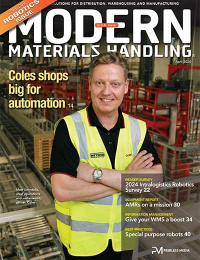
Latest Resources
